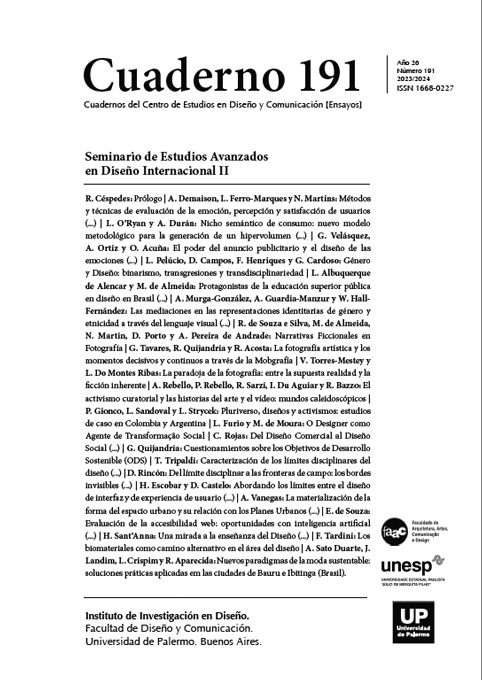Nuevos paradigmas de la moda sustentable: soluciones práticas aplicadas em las ciudades de Bauru e Ibitinga (Brasil)
Abstract
The textile and apparel chain is one of the most extensive and complex existing, involving several autonomous industrial segments whose interaction is fundamental for its organization.
References
ABNT – Associação Brasileira de Normas Técnicas (2004). NBR 10.004: 2004. Resíduos sólidos – Classificação. 71p.
Barnard, M. (2014). Fashion theory: An introduction. Routledge.
Bridgens, B., Powell, M., Farmer, G., Walsh, C., Reed, E., Royapoor, M., Gosling, P., Hall, J., Heidrich, O., (2018). Creative upcycling: reconnecting people, materials and place through making. J. Clean. Prod. 189, 145e154.
Borges, A. (2019). Design+ Artesanato: o caminho brasileiro. Editora Terceiro Nome.
Coppola, C., Vollero, A., & Siano, A. (2021). Consumer upcycling as emancipated selfproduction: Understanding motivations and identifying upcycler types. Journal of Cleaner Production, 285, 124812.
Echeverria, C. A., Handoko, W., Pahlevani, F., & Sahajwalla, V. (2019). Cascading use of textile waste for the advancement of fibre reinforced composites for building applications. Journal of Cleaner Production, 208, 1524-1536.
Fletcher, K., & Grose, L. (2012). Fashion & sustainability: Design for change. Hachette UK.
Ha-Brookshire, J., & Labat, K. L. (Eds.). (2015). Envisioning textile and apparel research and education for the 21st century (p. 38). International Textile and Apparel Association. IBGE – Instituto Brasileiro de Geografia e Estatística. (2021). Estimativas da população residente para os Municípios e para as Unidades da Federação brasileiros, com data de referência em 1º de julho de 2021. Disponível em: https://ftp.ibge.gov.br/Estimativas_de_Populacao/Estimativas_2021/estimativa_dou_ 2021.pdf. Acesso em 21/12/2021.
IEMI (2021). Brasil Têxtil 2021. Disponível em: https://www.yumpu.com/xx/document/read/64962385/brasil-textil-2021-abit. Acesso em 27/10/2022.
Islam, S. (2021). Waste management strategies in fashion and textiles industry: Challenges are in governance, materials culture and design-centric. In Waste Management in the Fashion and Textile Industries (pp. 275-293). Woodhead Publishing.
Jia, F., Yin, S., Chen, L., & Chen, X. (2020). The circular economy in the textile and apparel industry: A systematic literature review. Journal of Cleaner Production, 259, 120728.
Lorenzetti, L. (2018). A importância do reaproveitamento de resíduos têxteis em São Paulo. Disponível em: . Acesso em 18/02/2020.
MacArthur, E. (2017). A new textiles economy: Redesigning fashion’s future. 2017. Disponível em: . Acesso em: 25/08/2021.
Madeira, G. N. R. M. S. (2021). Superação das barreiras tecnológicas pelo setor têxtil segundo as premissas de Economia Circular.
Matushima, M. K. (2005). Especialização produtiva e aglomeração industrial: uma análise da indústria de confecções de Ibitinga-SP.
Parisi, M. L., Fatarella, E., Spinelli, D., Pogni, R., & Basosi, R. (2015). Environmental impact assessment of an eco-efficient production for coloured textiles. Journal of Cleaner Production, 108, 514-524. Prefeitura De Ibitinga (2022). Disponível em: https://www.ibitinga.sp.gov.br/cidade/aspectos-fisicos. Acesso em 26/09/2022.
Ribul, M., Lanot, A., Pisapia, C. T., Purnell, P., McQueen-Mason, S. J., & Baurley, S. (2021). Mechanical, chemical, biological: Moving towards closed-loop bio-based recycling in a circular economy of sustainable textiles. Journal of Cleaner Production, 326, 129325.
Reilly, A., & Kaiser, S. (2015). Imagining a Future without our Field. Envisioning Textile and Apparel Research and Education for the 21st Century, 11, 8-10.
Rodrigues, P. de C. (2014). A Produção de Sentidos sobre Inovação: Estudo de Caso sobre a Agência USP de Inovação, Dissertação de Mestrado, USP, São Paulo.
Sachs, I. (2000). Caminhos para o desenvolvimento sustentável. Editora Garamond.
SEBRAE - Serviço Brasileiro de Apoio às Micro e Pequenas Empresas. (2021). Distribuição dos estabelecimentos ativos 2021. Disponível em: https://datampe.sebrae.com.br/profile/geo/ibitinga#empresas-por-atividade-principal. Acesso em 18/09/2022.
Shirvanimoghaddam, K., Motamed, B., Ramakrishna, S., & Naebe, M. (2020). Death by waste: Fashion and textile circular economy case. Science of the Total Environment, 718, 137317.
Shrivastava, A., Jain, G., Kamble, S. S., & Belhadi, A. (2021). Sustainability through online renting clothing: Circular fashion fueled by instagram micro-celebrities. Journal of Cleaner Production, 278, 123772.
Singer, P. (2002). Introdução à economia solidária. São Paulo: Fundação Perseu Abramo.
Szaky, T., (2014). OutsmartWaste: the Modern Idea of Garbage and How to Think Our Way Out of it. Berrett-Koehler, San Francisco, CA.
Tobler-Rohr, M. I. (2011). Handbook of sustainable textile production. Elsevier.
WTO - World Trade Organization. (2021). World Trade Statistical Review 2021. Disponível em: https://www.wto.org/english/res_e/statis_e/wts2021_e/wts2021_e.pdf. Acesso em: 27/10/2022.
Los autores/as que publiquen en esta revista ceden los derechos de autor y de publicación a "Cuadernos del Centro de Estudios de Diseño y Comunicación", Aceptando el registro de su trabajo bajo una licencia de atribución de Creative Commons, que permite a terceros utilizar lo publicado siempre que de el crédito pertinente a los autores y a esta revista.


